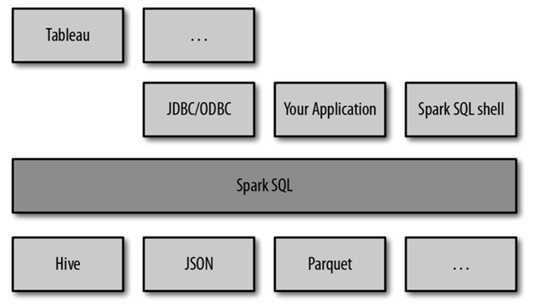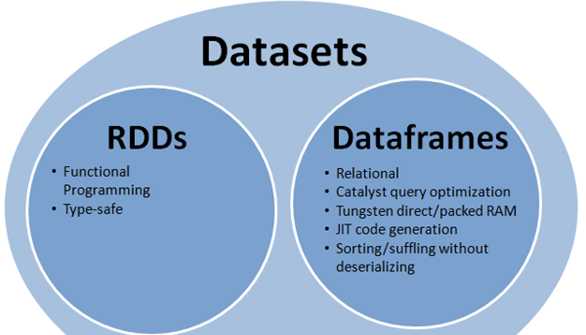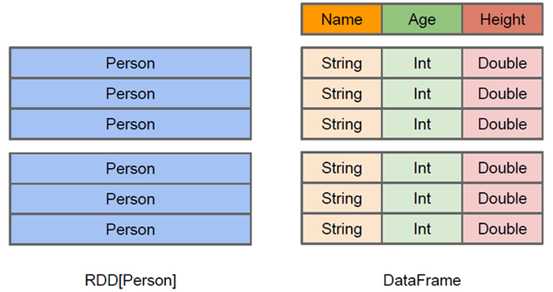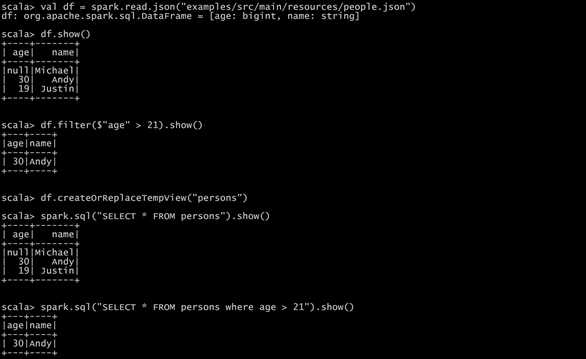标签:contex 并行 count() 固定 amp world 表头 分布式 nbsp
Spark SQL是Spark用来处理结构化数据的一个模块,它提供了一个编程抽象叫做DataFrame并且作为分布式SQL查询引擎的作用。
Hive是将Hive SQL转换成MapReduce然后提交到集群上执行,大大简化了编写MapReduce的程序的复杂性,由于MapReduce这种计算模型执行效率比较慢。所有Spark SQL的应运而生,它是将Spark SQL转换成RDD,然后提交到集群执行,执行效率非常快!
1.易整合

2.统一的数据访问方式

3.兼容Hive

4.标准的数据连接

SparkSQL可以看做是一个转换层,向下对接各种不同的结构化数据源,向上提供不同的数据访问方式。


在SparkSQL中Spark为我们提供了两个新的抽象,分别是DataFrame和DataSet。他们和RDD的区别,首先从版本的产生上来看:
RDD (Spark1.0) —> Dataframe(Spark1.3) —> Dataset(Spark1.6)
如果同样的数据都给到这三个数据结构,他们分别计算之后,都会给出相同的结果。不同是的他们的执行效率和执行方式。
在后期的Spark版本中,DataSet会逐步取代RDD和DataFrame成为唯一的API接口。
与RDD类似,DataFrame也是一个分布式数据容器。然而DataFrame更像传统数据库的二维表格,除了数据以外,还记录数据的结构信息,即schema。同时,与Hive类似,DataFrame也支持嵌套数据类型(struct、array和map)。从API易用性的角度上看,DataFrame API提供的是一套高层的关系操作,比函数式的RDD API要更加友好,门槛更低。由于与R和Pandas的DataFrame类似,Spark DataFrame很好地继承了传统单机数据分析的开发体验。

上图直观地体现了DataFrame和RDD的区别。左侧的RDD[Person]虽然以Person为类型参数,但Spark框架本身不了解Person类的内部结构。而右侧的DataFrame却提供了详细的结构信息,使得Spark SQL可以清楚地知道该数据集中包含哪些列,每列的名称和类型各是什么。DataFrame多了数据的结构信息,即schema。RDD是分布式的Java对象的集合。DataFrame是分布式的Row对象的集合。DataFrame除了提供了比RDD更丰富的算子以外,更重要的特点是提升执行效率、减少数据读取以及执行计划的优化,比如filter下推、裁剪等。
DataFrame是为数据提供了Schema的视图。可以把它当做数据库中的一张表来对待
DataFrame也是懒执行的。
性能上比RDD要高,主要有两方面原因:
定制化内存管理
数据以二进制的方式存在于非堆内存,节省了大量空间之外,还摆脱了GC(垃圾收集器)的限制。
查询优化器的意义在于,即便是经验并不丰富的程序员写出的次优的查询,也可以被尽量转换为高效的形式予以执行。
Dataframe的劣势在于在编译期缺少类型安全检查,导致运行时出错.
1) 是Dataframe API的一个扩展,是Spark最新的数据抽象
2) 用户友好的API风格,既具有类型安全检查也具有Dataframe的查询优化特性。
3) Dataset支持编解码器,当需要访问非堆上的数据时可以避免反序列化整个对象,提高了效率。
4) 样例类被用来在Dataset中定义数据的结构信息,样例类中每个属性的名称直接映射到DataSet中的字段名称。
5) Dataframe是Dataset的特列,DataFrame=Dataset[Row] ,所以可以通过as方法将Dataframe转换为Dataset。Row是一个类型,跟Car、Person这些的类型一样,所有的表结构信息都用Row来表示。
6) DataSet是强类型的。比如可以有Dataset[Car],Dataset[Person].
DataFrame只是知道字段,但是不知道字段的类型,所以在执行这些操作的时候是没办法在编译的时候检查是否类型失败的,比如你可以对一个String进行减法操作,在执行的时候才报错,而DataSet不仅仅知道字段,而且知道字段类型,所以有更严格的错误检查。就跟JSON对象和类对象之间的类比。
RDD让我们能够决定怎么做,而DataFrame和DataSet让我们决定做什么,控制的粒度不一样。
1、RDD、DataFrame、Dataset全都是spark平台下的分布式弹性数据集,为处理超大型数据提供便利
2、三者都有惰性机制,在进行创建、转换,如map方法时,不会立即执行,只有在遇到Action如foreach时,三者才会开始遍历运算,极端情况下,如果代码里面有创建、转换,但是后面没有在Action中使用对应的结果,在执行时会被直接跳过.
val sparkconf = new SparkConf().setMaster("local").setAppName("test").set("spark.port.maxRetries","1000") val spark = SparkSession.builder().config(sparkconf).getOrCreate() val rdd=spark.sparkContext.parallelize(Seq(("a", 1), ("b", 1), ("a", 1))) // map不运行 rdd.map{line=> println("运行") line._1 }
3、三者都会根据spark的内存情况自动缓存运算,这样即使数据量很大,也不用担心会内存溢出
4、三者都有partition的概念
5、三者有许多共同的函数,如filter,排序等
6、在对DataFrame和Dataset进行操作许多操作都需要这个包进行支持
import spark.implicits._
7、DataFrame和Dataset均可使用模式匹配获取各个字段的值和类型
DataFrame:
testDF.map{ case Row(col1:String,col2:Int)=> println(col1);println(col2) col1 case _=> "" }
Dataset:
case class Coltest(col1:String,col2:Int)extends Serializable //定义字段名和类型 testDS.map{ case Coltest(col1:String,col2:Int)=> println(col1);println(col2) col1 case _=> "" }
RDD:
1、RDD一般和spark mlib同时使用
2、RDD不支持sparksql操作
DataFrame:
1、与RDD和Dataset不同,DataFrame每一行的类型固定为Row,只有通过解析才能获取各个字段的值,如
testDF.foreach{ line => val col1=line.getAs[String]("col1") val col2=line.getAs[String]("col2") }
每一列的值没法直接访问
2、DataFrame与Dataset一般与spark ml同时使用
3、DataFrame与Dataset均支持sparksql的操作,比如select,groupby之类,还能注册临时表/视窗,进行sql语句操作,如
dataDF.createOrReplaceTempView("tmp")
spark.sql("select ROW,DATE from tmp where DATE is not null order by DATE").show(100,false)
4、DataFrame与Dataset支持一些特别方便的保存方式,比如保存成csv,可以带上表头,这样每一列的字段名一目了然
//保存 val saveoptions = Map("header" -> "true", "delimiter" -> "\t", "path" -> "hdfs://master01:9000/test") datawDF.write.format("com.atguigu.spark.csv").mode(SaveMode.Overwrite).options(saveoptions).save() //读取 val options = Map("header" -> "true", "delimiter" -> "\t", "path" -> "hdfs://master01:9000/test") val datarDF= spark.read.options(options).format("com.atguigu.spark.csv").load()
利用这样的保存方式,可以方便的获得字段名和列的对应,而且分隔符(delimiter)可以自由指定。
Dataset:
Dataset和DataFrame拥有完全相同的成员函数,区别只是每一行的数据类型不同。
DataFrame也可以叫Dataset[Row],每一行的类型是Row,不解析,每一行究竟有哪些字段,各个字段又是什么类型都无从得知,只能用上面提到的getAS方法或者共性中的第七条提到的模式匹配拿出特定字段
而Dataset中,每一行是什么类型是不一定的,在自定义了case class之后可以很自由的获得每一行的信息
case class Coltest(col1:String,col2:Int)extends Serializable //定义字段名和类型 /** rdd ("a", 1) ("b", 1) ("a", 1) **/ val test: Dataset[Coltest]=rdd.map{line=> Coltest(line._1,line._2) }.toDS test.map{ line=> println(line.col1) println(line.col2) }
可以看出,Dataset在需要访问列中的某个字段时是非常方便的,然而,如果要写一些适配性很强的函数时,如果使用Dataset,行的类型又不确定,可能是各种case class,无法实现适配,这时候用DataFrame即Dataset[Row]就能比较好的解决问题
打开Spark shell
例子:查询大于30岁的用户
创建如下JSON文件,注意JSON的格式:
{"name":"Michael"}
{"name":"Andy", "age":30}
{"name":"Justin", "age":19}

IDEA中程序的打包和运行方式都和SparkCore类似,Maven依赖中需要添加新的依赖项:
<dependency>
<groupId>org.apache.spark</groupId>
<artifactId>spark-sql_2.11</artifactId>
<version>${spark.version}</version>
<scope>provided</scope>
</dependency>
程序如下
package com.atguigu.sparksql import org.apache.spark.sql.SparkSession import org.apache.spark.{SparkConf, SparkContext} import org.slf4j.LoggerFactory /** * Created by wuyufei on 22/06/2019. */ object HelloWorld { val logger = LoggerFactory.getLogger(HelloWorld.getClass) def main(args: Array[String]) { //创建SparkConf()并设置App名称 val spark = SparkSession .builder() .appName("Spark SQL basic example") .config("spark.some.config.option", "some-value") .getOrCreate() // RDDs 转 DataFrames 需要的包 import spark.implicits._ val df = spark.read.json("examples/src/main/resources/people.json") df.show() df.filter($"age" > 21).show() df.createOrReplaceTempView("persons") spark.sql("SELECT * FROM persons where age > 21").show() spark.stop() } }
在老的版本中,SparkSQL提供两种SQL查询起始点,一个叫SQLContext,用于Spark自己提供的SQL查询,一个叫HiveContext,用于连接Hive的查询,SparkSession是Spark最新的SQL查询起始点,实质上是SQLContext和HiveContext的组合,所以在SQLContext和HiveContext上可用的API在SparkSession上同样是可以使用的。SparkSession内部封装了sparkContext,所以计算实际上是由sparkContext完成的。
import org.apache.spark.sql.SparkSession val spark = SparkSession .builder() .appName("Spark SQL basic example") .config("spark.some.config.option", "some-value") .getOrCreate() // RDDs 转 DataFrames 需要的包
import spark.implicits._
SparkSession.builder 用于创建一个SparkSession。
import spark.implicits._的引入是用于将DataFrames隐式转换成RDD,使df能够使用RDD中的方法。
如果需要Hive支持,则需要以下创建语句:
import org.apache.spark.sql.SparkSession val spark = SparkSession .builder() .appName("Spark SQL basic example") .config("spark.some.config.option", "some-value") .enableHiveSupport() .getOrCreate()
// RDDs 转 DataFrames 需要的包
import spark.implicits._
在Spark SQL中SparkSession是创建DataFrames和执行SQL的入口,创建DataFrames有三种方式,一种是可以从一个存在的RDD进行转换,还可以从Hive Table进行查询返回,或者通过Spark的数据源进行创建。
val df = spark.read.json("examples/src/main/resources/people.json")
df.show()
// +----+-------+
// | age| name|
// +----+-------+
// |null|Michael|
// | 30| Andy|
// | 19| Justin|
// +----+-------+
从RDD进行转换:
scala> val peopleRdd = sc.textFile("examples/src/main/resources/people.txt") peopleRdd: org.apache.spark.rdd.RDD[String] = examples/src/main/resources/people.txt MapPartitionsRDD[18] at textFile at <console>:24 //把每一行的数据用,隔开 然后通过第二个map转换成一个Array 再通过toDF 映射给name age scala> val peopleDF3 = peopleRdd.map(_.split(",")).map(paras => (paras(0),paras(1).trim().toInt)).toDF("name","age") peopleDF3: org.apache.spark.sql.DataFrame = [name: string, age: int] scala> peopleDF.show() +-------+---+ | name|age| +-------+---+ |Michael| 29| | Andy| 30| | Justin| 19| +-------+---+
Hive在数据源章节介绍
import spark.implicits._ df.printSchema() // root // |-- age: long (nullable = true) // |-- name: string (nullable = true) df.select("name").show() // +-------+ // | name| // +-------+ // |Michael| // | Andy| // | Justin| // +-------+ df.select($"name", $"age" + 1).show() // +-------+---------+ // | name|(age + 1)| // +-------+---------+ // |Michael| null| // | Andy| 31| // | Justin| 20| // +-------+---------+ df.filter($"age" > 21).show() // +---+----+ // |age|name| // +---+----+ // | 30|Andy| // +---+----+ df.groupBy("age").count().show() // +----+-----+ // | age|count| // +----+-----+ // | 19| 1| // |null| 1| // | 30| 1| // +----+-----+
// Register the DataFrame as a SQL temporary view df.createOrReplaceTempView("people") val sqlDF = spark.sql("SELECT * FROM people") sqlDF.show() // +----+-------+ // | age| name| // +----+-------+ // |null|Michael| // | 30| Andy| // | 19| Justin| // +----+-------+ // Register the DataFrame as a global temporary view df.createGlobalTempView("people") // Global temporary view is tied to a system preserved database `global_temp` spark.sql("SELECT * FROM global_temp.people").show() // +----+-------+ // | age| name| // +----+-------+ // |null|Michael| // | 30| Andy| // | 19| Justin| // +----+-------+ // Global temporary view is cross-session spark.newSession().sql("SELECT * FROM global_temp.people").show() // +----+-------+ // | age| name| // +----+-------+ // |null|Michael| // | 30| Andy| // | 19| Justin| // +----+-------+
临时表是Session范围内的,Session退出后,表就失效了。如果想应用范围内有效,可以使用全局表。注意使用全局表时需要全路径访问,如:global_temp.people
Dataset是具有强类型的数据集合,需要提供对应的类型信息。
case class Person(name: String, age: Long) // Encoders are created for case classes val caseClassDS = Seq(Person("Andy", 32)).toDS() caseClassDS.show() // +----+---+ // |name|age| // +----+---+ // |Andy| 32| // +----+---+ // Encoders for most common types are automatically provided by importing spark.implicits._ val primitiveDS = Seq(1, 2, 3).toDS() primitiveDS.map(_ + 1).collect() // Returns: Array(2, 3, 4) // DataFrames can be converted to a Dataset by providing a class. Mapping will be done by name val path = "examples/src/main/resources/people.json" val peopleDS = spark.read.json(path).as[Person] peopleDS.show() // +----+-------+ // | age| name| // +----+-------+ // |null|Michael| // | 30| Andy| // | 19| Justin| // +----+-------+
Spark SQL支持通过两种方式将存在的RDD转换为Dataset,转换的过程中需要让Dataset获取RDD中的Schema信息,主要有两种方式,一种是通过反射来获取RDD中的Schema信息。这种方式适合于列名已知的情况下。第二种是通过编程接口的方式将Schema信息应用于RDD,这种方式可以处理那种在运行时才能知道列的方式。
SparkSQL能够自动将包含有case类的RDD转换成DataFrame,case类定义了table的结构,case类属性通过反射变成了表的列名。Case类可以包含诸如Seqs或者Array等复杂的结构。
// For implicit conversions from RDDs to DataFrames import spark.implicits._ // Create an RDD of Person objects from a text file, convert it to a Dataframe val peopleDF = spark.sparkContext .textFile("examples/src/main/resources/people.txt") .map(_.split(",")) .map(attributes => Person(attributes(0), attributes(1).trim.toInt)) .toDF() // Register the DataFrame as a temporary view peopleDF.createOrReplaceTempView("people") // SQL statements can be run by using the sql methods provided by Spark val teenagersDF = spark.sql("SELECT name, age FROM people WHERE age BETWEEN 13 AND 19") // The columns of a row in the result can be accessed by field index teenagersDF.map(teenager => "Name: " + teenager(0)).show() // +------------+ // | value| // +------------+ // |Name: Justin| // +------------+ // or by field name teenagersDF.map(teenager => "Name: " + teenager.getAs[String]("name")).show() // +------------+ // | value| // +------------+ // |Name: Justin| // +------------+ // No pre-defined encoders for Dataset[Map[K,V]], define explicitly implicit val mapEncoder = org.apache.spark.sql.Encoders.kryo[Map[String, Any]] // Primitive types and case classes can be also defined as // implicit val stringIntMapEncoder: Encoder[Map[String, Any]] = ExpressionEncoder() // row.getValuesMap[T] retrieves multiple columns at once into a Map[String, T] teenagersDF.map(teenager => teenager.getValuesMap[Any](List("name", "age"))).collect() // Array(Map("name" -> "Justin", "age" -> 19))
如果case类不能够提前定义,可以通过下面三个步骤定义一个DataFrame
创建一个多行结构的RDD;
创建用StructType来表示的行结构信息。
通过SparkSession提供的createDataFrame方法来应用Schema .
import org.apache.spark.sql.types._ // Create an RDD val peopleRDD = spark.sparkContext.textFile("examples/src/main/resources/people.txt") // The schema is encoded in a string val schemaString = "name age" // Generate the schema based on the string of schema val fields = schemaString.split(" ") .map(fieldName => StructField(fieldName, StringType, nullable = true)) val schema = StructType(fields) // Convert records of the RDD (people) to Rows import org.apache.spark.sql._ val rowRDD = peopleRDD .map(_.split(",")) .map(attributes => Row(attributes(0), attributes(1).trim)) // Apply the schema to the RDD val peopleDF = spark.createDataFrame(rowRDD, schema) // Creates a temporary view using the DataFrame peopleDF.createOrReplaceTempView("people") // SQL can be run over a temporary view created using DataFrames val results = spark.sql("SELECT name FROM people") // The results of SQL queries are DataFrames and support all the normal RDD operations // The columns of a row in the result can be accessed by field index or by field name results.map(attributes => "Name: " + attributes().show() // +-------------+ // | value| // +-------------+ // |Name: Michael| // | Name: Andy| // | Name: Justin| // +-------------+
RDD、DataFrame、Dataset三者有许多共性,有各自适用的场景常常需要在三者之间转换
DataFrame/Dataset转RDD:
val rdd1=testDF.rdd
val rdd2=testDS.rdd
RDD转DataFrame:
import spark.implicits._ val testDF = rdd.map {line=> (line._1,line._2) }.toDF("col1","col2")
一般用元组把一行的数据写在一起,然后在toDF中指定字段名
RDD转Dataset:
import spark.implicits._ case class Coltest(col1:String,col2:Int)extends Serializable //定义字段名和类型 val testDS = rdd.map {line=> Coltest(line._1,line._2) }.toDS
可以看到,定义每一行的类型(case class)时,已经给出了字段名和类型,后面只要往case class里面添加值即可
Dataset转DataFrame:
把case class封装成Row
import spark.implicits._ val testDF = testDS.toDF
DataFrame转Dataset:
import spark.implicits._ case class Coltest(col1:String,col2:Int)extends Serializable //定义字段名和类型 val testDS = testDF.as[Coltest]
这种方法就是在给出每一列的类型后,使用as方法,转成Dataset,这在数据类型是DataFrame又需要针对各个字段处理时极为方便。
在使用一些特殊的操作时,一定要加上 import spark.implicits._ 不然toDF、toDS无法使用
通过spark.udf功能用户可以自定义函数。
scala> val df = spark.read.json("examples/src/main/resources/people.json")
df: org.apache.spark.sql.DataFrame = [age: bigint, name: string]
scala> df.show()
+----+-------+
| age| name|
+----+-------+
|null|Michael|
| 30| Andy|
| 19| Justin|
+----+-------+
scala> spark.udf.register("addName", (x:String)=> "Name:"+x)
res5: org.apache.spark.sql.expressions.UserDefinedFunction = UserDefinedFunction(<function1>,StringType,Some(List(StringType)))
scala> df.createOrReplaceTempView("people")
scala> spark.sql("Select addName(name), age from people").show()
+-----------------+----+
|UDF:addName(name)| age|
+-----------------+----+
| Name:Michael|null|
| Name:Andy| 30|
| Name:Justin| 19|
+-----------------+----+
强类型的Dataset和弱类型的DataFrame都提供了相关的聚合函数, 如 count(),countDistinct(),avg(),max(),min()。除此之外,用户可以设定自己的自定义聚合函数。
通过继承UserDefinedAggregateFunction来实现用户自定义聚合函数。下面展示一个求平均工资的自定义聚合函数。
import org.apache.spark.sql.expressions.MutableAggregationBuffer import org.apache.spark.sql.expressions.UserDefinedAggregateFunction import org.apache.spark.sql.types._ import org.apache.spark.sql.Row import org.apache.spark.sql.SparkSession object MyAverage extends UserDefinedAggregateFunction { // 聚合函数输入参数的数据类型 def inputSchema: StructType = StructType(StructField("inputColumn", LongType) :: Nil) // 聚合缓冲区中值得数据类型 def bufferSchema: StructType = { StructType(StructField("sum", LongType) :: StructField("count", LongType) :: Nil) } // 返回值的数据类型 def dataType: DataType = DoubleType // 对于相同的输入是否一直返回相同的输出。 def deterministic: Boolean = true // 初始化 def initialize(buffer: MutableAggregationBuffer): Unit = { // 存工资的总额 buffer(0) = 0L // 存工资的个数 buffer(1) = 0L } // 相同Execute间的数据合并。 def update(buffer: MutableAggregationBuffer, input: Row): Unit = { if (!input.isNullAt(0)) { buffer(0) = buffer.getLong(0) + input.getLong(0) buffer(1) = buffer.getLong(1) + 1 } } // 不同Execute间的数据合并 def merge(buffer1: MutableAggregationBuffer, buffer2: Row): Unit = { buffer1(0) = buffer1.getLong(0) + buffer2.getLong(0) buffer1(1) = buffer1.getLong(1) + buffer2.getLong(1) } // 计算最终结果 def evaluate(buffer: Row): Double = buffer.getLong(0).toDouble / buffer.getLong(1) } // 注册函数 spark.udf.register("myAverage", MyAverage) val df = spark.read.json("examples/src/main/resources/employees.json") df.createOrReplaceTempView("employees") df.show() // +-------+------+ // | name|salary| // +-------+------+ // |Michael| 3000| // | Andy| 4500| // | Justin| 3500| // | Berta| 4000| // +-------+------+ val result = spark.sql("SELECT myAverage(salary) as average_salary FROM employees") result.show() // +--------------+ // |average_salary| // +--------------+ // | 3750.0| // +--------------+
通过继承Aggregator来实现强类型自定义聚合函数,同样是求平均工资
import org.apache.spark.sql.expressions.Aggregator import org.apache.spark.sql.Encoder import org.apache.spark.sql.Encoders import org.apache.spark.sql.SparkSession // 既然是强类型,可能有case类 case class Employee(name: String, salary: Long) case class Average(var sum: Long, var count: Long) object MyAverage extends Aggregator[Employee, Average, Double] { // 定义一个数据结构,保存工资总数和工资总个数,初始都为0 def zero: Average = Average(0L, 0L) // Combine two values to produce a new value. For performance, the function may modify `buffer` // and return it instead of constructing a new object def reduce(buffer: Average, employee: Employee): Average = { buffer.sum += employee.salary buffer.count += 1 buffer } // 聚合不同execute的结果 def merge(b1: Average, b2: Average): Average = { b1.sum += b2.sum b1.count += b2.count b1 } // 计算输出 def finish(reduction: Average): Double = reduction.sum.toDouble / reduction.count // 设定之间值类型的编码器,要转换成case类 // Encoders.product是进行scala元组和case类转换的编码器 def bufferEncoder: Encoder[Average] = Encoders.product // 设定最终输出值的编码器 def outputEncoder: Encoder[Double] = Encoders.scalaDouble } val ds = spark.read.json("examples/src/main/resources/employees.json").as[Employee] ds.show() // +-------+------+ // | name|salary| // +-------+------+ // |Michael| 3000| // | Andy| 4500| // | Justin| 3500| // | Berta| 4000| // +-------+------+ // Convert the function to a `TypedColumn` and give it a name val averageSalary = MyAverage.toColumn.name("average_salary") val result = ds.select(averageSalary) result.show() // +--------------+ // |average_salary| // +--------------+ // | 3750.0| // +--------------+
标签:contex 并行 count() 固定 amp world 表头 分布式 nbsp
原文地址:https://www.cnblogs.com/GH-123/p/11069883.html